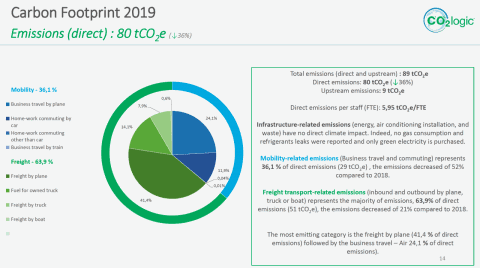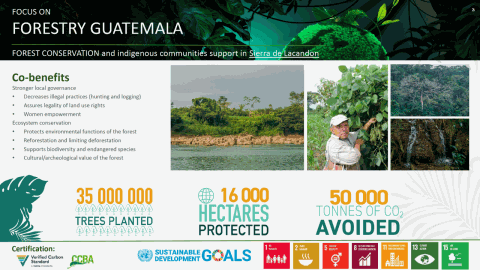Laurent Mercier for Artnet - 26 January 2021
As we all know, climate change is the biggest threat to humans on earth.
It is a challenge self-inflicted by our economic activity, and therefore individuals and businesses alike need to take accountability for the damage we do by taking steps to alleviate our impact on the planet.
Carbon offsetting, which is the process of funding emission-reduction initiatives in an effort to “balance out” your carbon footprint, is one step every responsible business should take as part of its climate action plan.
While businesses should first take steps to reduce their greenhouse gas emissions, even after significant changes to operations, some emissions will remain. The next step is to calculate the remaining carbon footprint, and finally take responsibility by financially offsetting those emissions. Money can be invested in projects that plant trees or protect forests, support renewable energy programs, or other planet-saving initiatives.
Combating climate change is intersectional and needs to be considered not only from an environmental perspective but also from a social, political, global health, and economic perspective. While it can be hard to decide how to factor these concerns into your business priorities, investing in offsetting initiatives, which often take place in developing nations, is an accessible way for businesses to engage with this outside of their day-to-day operations.
By doing so, we work towards a healthy future for current and future generations. Businesses who don’t do this, should, in my opinion, be boycotted for their role in stealing the future away from others.
WHY BEING ECO-CONSCIOUS IS GOOD FOR BUSINESS
Offsetting CO2 emissions, after taking measures to reduce them, will not have a negative impact on your business plan, and will have a positive impact on the climate. In fact at my gallery, Maruani Mercier, we have found that millennial collectors in particular are very positive about our initiative, and that it influences their decision to work with us.
Maruani Mercier’s carbon footprint in 2018 was 125 tCO2e (tons of direct emissions) and in 2019 we managed to reduce that to 80 tCO2e, which is a decrease of 36 percent (while the gallery’s turnover increased by 26 percent!).
How did we do this? We consciously reduced our business travel by plane, reducing travel emissions by 62 percent, and shipped more freight overseas instead of by air for a further 26 percent reduction in emissions from shipping. We also eliminated emissions from our infrastructure by buying green electricity from renewable sources only. After these steps, we offset the remaining carbon emissions.
For a gallery, the four main activities that produce greenhouse emissions are: transport of art, business travel (including daily home-work commuting), and the energy used in our galleries. We need to know how many tons of art we have transported in a given year, over what distance, and how (sea, air, road).
In order to facilitate our calculations, we work with only one international shipping company that at the end of the year supplies us this information. For local transport, we have our own truck.
After moving art, a gallery’s second highest impact will probably be business travel, so each air-mile needs to be accounted for. This data can easily be tracked internally when booking flights or through a travel agent at no additional expense. Transportation to and from the galleries by all employees will also have an impact on greenhouse emissions.
And finally, the energy consumption of our spaces needs to be accounted for, unless—like Maruani Mercier—you already buy from renewable sources.
Once the numbers are recorded you can either calculate your carbon footprint yourself or submit the information to professional organizations, and act on it. After reducing where we could across the gallery’s logistics and travel, I estimated the total cost of offsetting Maruani Mercier’s complete operations at €3,000 for 2019—this includes the entire gallery team.
WHERE TO OFFSET YOUR CARBON FOOTPRINT
Established offsetting organisations have quantified projects in different parts of the world where the efficiency is highest on a cost/ton CO2 basis. We use CO2logic, a company that also proposes credible climate projects that reduce or avoid greenhouse gas emissions or sequester greenhouse gases. These projects also provide social and environmental co-benefits in line with the Sustainable Development goals of the United Nations.
Our 2018 emissions were offset by acquiring efficient fire stoves in Malawi. In many rural places around the world, daily cooking still happens on open fires, which puts a lot of pressure on the forest if the demand for firewood keeps rising in line with a growing population. This project reduces firewood consumption and has a positive impact on the health of the population through minimizing exposure to smoke.
Our 2019 emissions are in the process of being offset by reforestation and conservation in Guatemala. This project protects habitat of endangered species and avoids the deforestation of tropical forest.
Ultimately, it is up to you where you want to invest to offset your carbon. Finding the right fit will be rewarding, and you can sleep soundly knowing that you have done your part to protect the reputation of your business, and the health of the planet.
Laurent Mercier is managing partner at the Belgian gallery MARUANI MERCIER.



